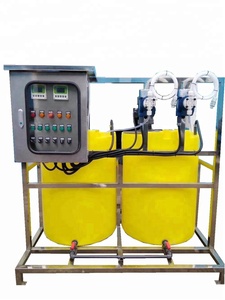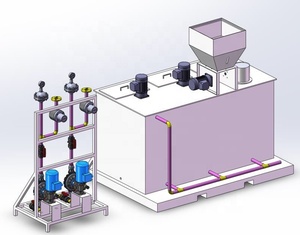
All categories
Featured selections
Trade Assurance
Buyer Central
Help Center
Get the app
Become a supplier

(3166 products available)



























A powder dosing system is a type of automated machinery that is used to add accurate amounts of powder to various types of products. Such systems are usually found in the food, pharmaceutical, and chemical industries, among others, where accuracy is essential. There are several types of powder dosing machines, each with its own unique features and applications:
These dosing systems use a hopper or container to hold the powder before it is transferred to a storage or process vessel. The powder is then weighed, and the amount to be dispensed is calculated. Once the calculation is complete, the powder is dispensed into the desired area. The batch weighing system is ideal for powders of low value, those with a wide range of properties, or those that require a high level of accuracy.
An auger powder dosing system uses a rotating screw to move the powder from the hopper to the destination. The speed and rotation of the auger are controlled to dispense the correct amount of powder accurately. This type of dosing system is suitable for free-flowing powders that require high accuracy. Additionally, the auger dosing system is commonly used in pharmaceuticals, food, and chemical industries.
The volumetric powder dosing system dispenses a specific volume of powder based on the size of the container or hopper. This is achieved by controlling the movement of the powder to fill the container to the required level. Volumetric dosing machines are suitable for powders of uniform density and those that are easily compressed. These dosing systems are often used in the food and construction industries.
A loss-in-weight powder dosing system dispenses a specific amount of powder by measuring the loss of weight in the hopper as the powder is being dispensed. The weight loss is used to calculate the amount of powder that has been dispensed, ensuring accuracy. This type of dosing system is suitable for operations that require high accuracy and precise control, such as in the pharmaceutical and food industries.
Micro-dosing systems are designed to accurately dispense tiny amounts of powder. These systems are commonly used in the pharmaceutical and biotechnology industries where precision is essential. Micro-dosing systems are also used in research and development labs.
The following are specifications and maintenance tips for powder dosing systems.
Capacity: The capacity of the powder dosing system is determined by the total weight or volume of the powder it can handle. This is usually expressed in kilograms per hour or liters per minute. The capacity of the powder dosing system should meet the production needs for a specific period.
Precision: The precision of the powder dosing system refers to the accuracy of the amount of powder it dispenses. It is usually expressed as a percentage of the target value or a standard deviation. The precision of the powder dosing system should meet the required accuracy of the production process.
Multiple ingredients: The powder dosing system can handle multiple powders and ingredients. This feature is suitable for complicated production processes that require mixing various powders in precise proportions.
Integration: The powder dosing system can integrate with production lines, control systems, and data acquisition systems. It enables seamless communication and cooperation between the powder dosing system and other equipment.
Adaptability: The powder dosing system can adapt to different types of powders, such as fine powders, granules, and bulk materials. It is crucial to ensure the proper operation of the dosing system for different powder types.
Regular cleaning: In order to avoid the blockage and contamination of the powder dosing system, users should regularly clean the hoppers, conveyors, and dosing components. When switching between different powders, thorough cleaning of the system is required to prevent cross-contamination.
Calibration: Regular calibration of the powder dosing system is essential to maintain accurate dispensing. Users can check and adjust the parameters and settings of the dosing system to ensure that it is within the required tolerance range.
Lubrication: The moving parts and components of the powder dosing system that require lubrication should be lubricated regularly. This will reduce friction and wear, helping to maintain the smooth and stable operation of the system.
Inspection of parts: Users should inspect the parts and components of the powder dosing system, such as belts, motors, sensors, etc. Any sign of damage or wear should be replaced or repaired in time to avoid failure during operation.
Automated powder dosing systems have many applications in different industries. Here are some of the common usage scenarios of the devices.
In the Pharmaceutical industry, a powder dosing system often accurately measures and dispenses various types of drugs, such as pills, capsules, and tablets. The system ensures precise dosage control and consistency, which is critical for drug effectiveness and safety.
The powder dosing system is widely used in the food and beverage industry to mix ingredients, such as spices, flavors, and nutritional supplements, into food products. It ensures uniform distribution and accurate dosing, maintaining product quality and taste consistency.
When it comes to the chemical industry, powder dosing systems are used to compound and blend various types of chemicals, including pigments, dyes, and additives. These systems ensure precise measurement and mixing, which is essential for product quality and consistency.
Powder dosing systems play an important role in the construction industry. They are used to dispense cement, mortar, and other powdered materials for batching, mixing, and filling applications. The dosing systems ensure accurate proportioning and dispensing, which is crucial for achieving desired strength and uniformity in construction materials.
In the automotive and aerospace industries, powder dosing systems are used for coating and painting applications, such as applying powder coatings and adhesives. These systems ensure precise deposition of materials onto substrates, achieving uniform coverage and quality finishes.
The powder dosing system can also be used in the environmental sector, such as dispensing fertilizers and pesticides in agriculture. These systems ensure accurate application of chemicals for plant growth and pest control.
Overall, powder dosing systems are versatile tools that provide accurate and efficient dosing solutions for various industries and applications.
Choosing the right powder dosing system for a particular application requires careful consideration of several key factors.
First, consider the types of powder materials to be handled, including their flow characteristics, bulk densities, and whether they are free-flowing or cohesive. Select a dosing system that can effectively handle these specific powder properties to ensure accurate and consistent dosing.
Consider the required dosing accuracy and precision for the application. Different dosing systems offer varying levels of accuracy, so choose one that can meet the desired dosage targets within acceptable tolerances.
Determine the required throughput or dosing rate for the application, which is typically specified in terms of volume, weight, or units of powder per unit of time. Select a dosing system that can achieve the necessary throughput while maintaining accurate dosing performance.
Consider the production environment in which the dosing system will be used, including factors such as hygiene requirements, explosive atmospheres, and the need for containment. Choose a dosing system that is compatible with the production environment and can meet relevant safety and regulatory standards.
If automation and integration are important for the application, select a dosing system that can be easily integrated into existing production lines or control systems. Ensure that the dosing system is compatible with the required automation interfaces and protocols.
Consider the maintenance requirements of the dosing system, including factors such as cleaning procedures, spare parts availability, and technical support. Choose a dosing system with reliable support and maintenance resources to ensure ongoing performance and reliability.
Q1: What is the main function of a powder dosing system?
A1: The primary function of a powder dosing system is to provide an accurate and controlled way of measuring and dispensing powder materials.
Q2: What are the benefits of using a powder dosing system?
A2: Using a powder dosing system offers numerous benefits. Some of which include the ability to accurately control the dosing, improve efficiency, enhance product quality, and maintain safety by reducing powder spillage and dust generation.
Q3: What are the key factors to consider when purchasing a powder dosing system?
A3: Some key factors to consider when purchasing a powder dosing system include the type of powder material, the required accuracy of dosing, the desired throughput capacity, the compatibility with existing equipment and production processes, and any specific regulatory compliance requirements.
Q4: Can a powder dosing system be customized for unique requirements?
A4: Yes, some manufacturers may offer customization options for unique requirements. This can involve adapting the system to fit specific production processes, integrating with other equipment, or fine-tuning control settings.